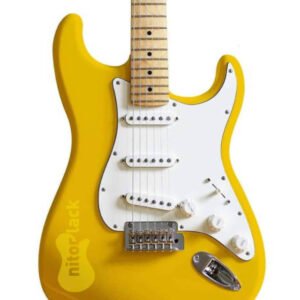Description
Our vintage-inspired colors
The Nitorlack colors are based on the original Fender and Gibson colors. The creation of these colors is preceded by a great work and a thorough study by our laboratory and technical department. This has allowed us to faithfully recreate the sound of Fender and Gibson guitars from the 50s and 60s.
During these years until today, it should be noted that the Vintage guitar colors have varied greatly over the years due to the aging of the nitrocellulose lacquer and modifications in the colors of the brands themselves.
Therefore, two guitars finished in 1960 with fender colors today may be totally different from each other or from a more current guitar.
Application guide:
- We begin to apply the colour once the guitar has been dabbed with Nitorlack Primer.
- When we start the painting work, the pores must be closed and the grain must not be marked.
- Apply the product either by spray or spray gun at a distance of about 25 cm.
- When applying we must follow a pattern of application, first horizontally and then vertically, applying the paint evenly.
- Apply several coats, letting them dry for about 24 hours and sanding between them to remove any remaining impurities.
- This work shall be completed when the surface is completely smooth and free of imperfections.
FAQ:
How many sprays do I need to varnish a guitar?
– If the surface is well coated and it is not your first project, you can do it with one spray, although you will not apply many coats. However if you are not an expert we recommend using 2 sprays for an optimal finish.
What temperature should the guitar be at during and after the process?
– It is recommended to be done in a place where the temperature is between 15 and 25 degrees.
Where should I carry out the process
A clean site will be essential, to prevent dirt or dust particles from adhering to the surface.








Reviews
There are no reviews yet.